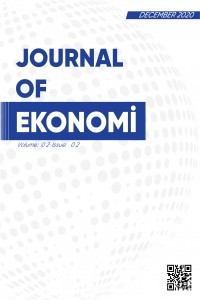Türkiye’de işgücü piyasasında eğitim seviyesi genç işsizlik üzerindeki etkili mi? Ekonometrik analiz
Bu çalışmada Türkiye’de önemli bir sorun olan genç işsizliği ile eğitim seviyesi arasındaki ilişki irdelenmektedir. Türkiye’nin genç nüfusuna iş fırsatı oluşturamadığı, devamlı artan genç işsizlik seviyelerinden anlaşılmaktadır. Çalışmada öncelikle bu durumun nedenleri irdelenmiştir. Literatür taramasının ardından yapılan ekonometrik analizde Johansen-Juselius eşbütünleşme yöntemiyle değişkenler arasındaki eş bütünleşme ilişkisi incelenmiştir. Analiz sonucuna göre ilgili dönemde lise ve yüksek eğitimdeki artışın genç işsizlik üzerinde azaltıcı bir etkiye sahip olduğu anlaşılmaktadır.
Anahtar Kelimeler:
Genç İşsizliği, Eğitim Seviyesi, İstihdam
Does education level effective on youth unemployment ın Turkish labor market: Empirical analysis
In this study, youth unemployment is a major problem in relations between Turkey and the educational level is examined. It is understood from the ever-increasing levels of youth unemployment that Turkey's young population cannot create a business opportunity. The reasons of this situation are firstly examined in the study, After the literature review, relationships among the variables are tested by Johansen-Juselius cointegration method. According to the results of the analysis, it is understood that the increase in high school and higher education has a decreasing effect on the youth unemployment in the related period.
Keywords:
Youth unemployment, education level, employment,
___
- Barro, R. (2002). Education and economicgrowth. Annals of Economics and Finance, 14(2):301-3293 (Çevrim içi, Erişim Tarihi 22.5.2018).
- Ceylan, B. (1999). İşgücü piyasası ve istihdam politikasının temel prensipleri. Ankara Üniversitesi Siyasal Bilimler Fakültesi İstihdam ve Danışmanlık Hizmetleri Eğitim Programı, Ankara.
- Çalışkan, Ş. (2007). Eğitim-işsizlik ve yoksulluk ilişkisi. Sosyal ve Ekonomik Araştırmalar Dergisi, 7(13): 285-308.
- Çondur, F. ve Bölükbaş, M. (2014). Türkiye’de İşgücü Piyasası ve Genç İşsizlik- Büyüme İlişkisi Üzerine Bir İnceleme, Amme İdaresi Dergisi, 47(2), 77-93 (Çevrim içi, Erişim Tarihi 10.7.2019)
- Dickey, D. ve Fuller, W. A. (1981). Likelihood ratio statistics forautoregressive time series with a unitroot. Econometrica, 49(4):1057-1072.
- Enders, W. (1995). Applied Econometric Time Series, John Wiley&Sons.
- Engle, R. F. and C. W. J. Granger (1987). Co-integrationandErrorCorrection: Representation, Estimation, andTesting”, Econometrica, Vol 55, 251– 276
- Granger, C.W.J. ve Newbold, P. (1973). Somecomments on theevaluation of economicforecasts. Applied Economics ,5: 35-47.
- Johansen, S. ve Juselius, K. (1990). Maximum likelihood estimation and ınference on co-integration – with Applications to the deman dfor Money. Oxford Bulletin of Economics and Statisitics, 52(2): 169-210.
- Johansen, S. (1988). Statistical Analysis of Cointegrating Vectors. Journal of Economic Dynamics and Control, 12: 231-254.
- Krueger, A. ve Lindahl, M. (2001). Education for growth: Why and for whom?. Journal of Economic Literature, 43-49.
- Krueger, A. B. ve Jorn, S.P. A. (1995). Comparative analysis of east and west german labor markets: before and after unification, in richard freeman and lawrence katz, Eds., Differences and changes in wage structures. (Chicago and London: University of Chicago Press, 1995): 405-45.
- Kwiatlwski , D., Phillips, P.C.B., Schmidt, P., ve Shin, Y., (1992). Testing the null of stationarity against the alternative of a unit root: how sure are we economic time series have a unitroot?. Econometrics, 54: 159–178.
- Msigwa, R. ve Kipesha, E. F. (2013). Determinants of youth unemployment in developin gcountries: Evidences from Tanzania, Journal of Economics and Sustainable Development , 4(14): 67-77.
- Sandalcılar, A.R.( 2012). Türkiye’de kağıt tüketimi ile ekonomik büyüme arasındaki ilişki: Eşbütünleşme ve nedensellk analizi, C.Ü. İktisadi ve İdari Bilimler Dergisi, 13(2):1-15.
- Sayın, F. ( 2012). Türkiye’de 1988-2010 döneminde eğitim ve büyümenin genç işsizliğine etkisinin analizi. Dokuz Eylül Üniversitesi Sosyal Bilimler Enstitüsü Dergisi, 13(4): 33-53.
- Seçer, B. (2006). Uluslararası boyutuyla genç işsizliği ve gençlere yönelik istihdam politikaları. TİSK Akademi, 1(2).
- Şentürk, F. (2015). Türkiye’de işgücü piyasası ve istihdamın yapısı. Sosyal Güvence Dergisi, 7: 113-143. 93 (Çevrim içi, Erişim Tarihi 10.7.2019).
- Tansel, A., Ozdemir, Z. A. ve Aksoy, E. (2015). Unemployment and labor force participation in Turkey. Applied Economics Letters, 23(3): 184–187.
- TÜİK, (2015). İstatistiklerle Gençlik 2014, file:///C:/Users/davuthang%C3%BCnayd%C4%B1n/Downloads /6296888986103653051..pdf (27.07.2015).
- UNDP (2008). Türkiye 2008 İnsani Gelişme Raporu: Türkiye’de Gençlik. Birleşmiş Milletler Kalkınma Programı Türkiye Temsilciliği, Ankara.
- Yenilmez, F. Ve Kılıç, E.(2018). Türkiye’de işgücüne katılma oranı-işsizlik oranı ilişkisi: cinsiyet ve eğitim düzeyine dayalı bir analiz. Eskişehir Osmangazi Üniversitesi İİBF Dergisi, 13(2): 55 – 76, 93 (Çevrim içi, Erişim Tarihi 10.5.2018).
- Yayın Aralığı: Yılda 2 Sayı
- Başlangıç: 2019
- Yayıncı: Cem IŞIK
Sayıdaki Diğer Makaleler
Ramina MUSATAFAYEVA, Rukhiya GAMBAROVA, Yegana ABBASOVA
Getiri farkı resesyonu tahmin edebilir mi? Türkiye sanayi üretimi örneği
Türkiye’de kadın istihdamının önemi ve kadın istihdamının artırılmasına yönelik yapılan çalışmalar
Şanlıurfa’daki yem bitkileri eken çiftçilerin sosyo-ekonomik profilinin analizi
Mustafa AYDOĞDU, İlay AYDOĞDU, Cenap CEVHERİ, Mehmet Reşit SEVİNÇ, Nihat KÜÇÜK
Sağlık ve iş performası ölçeği’nin Türkçe’ye uyarlanması: güvenilirlik ve geçerlilik analizi
Peren teoremi: İçinde yaşadığımız matematiksel çerçeve
Franz W. PEREN, Pınar D. AKYAZGAN, Çevirmen: Pınar D. AKYAZGAN
Türkiye’de işgücü piyasasında eğitim seviyesi genç işsizlik üzerindeki etkili mi? Ekonometrik analiz
